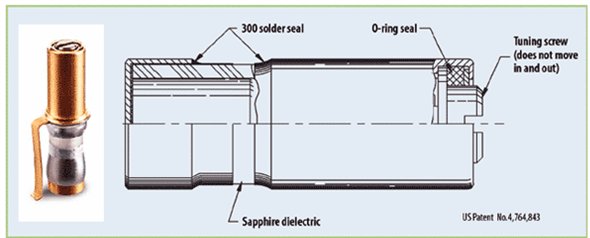As you already know, capacitors are essential circuit elements for storing and suppling charge on demand. For inductors and resistors, capacitors act as the building blocks of passive circuits and the supporting components for active circuits. While a wide range of fixed-value capacitors are used in most electrical circuits, it is sometimes preferable, or necessary, to use a component with a variable capacitance range.
These variable capacitors are known as trimmer capacitors because these capacitors can be used to trim the performance of both active and passive circuits. These components allow for variable tuning – think oscillator frequency values or rise and fall times. Additionally, if values drift over the life of a device, trimmer capacitors can be recalibrated as needed. For sensitive applications like magnetic resonance imaging (MRI), these components help optimize performance where any instability in time or temperature could impact the image output.
High-Level Trade-Offs to Consider When Evaluating Capacitor Types
When designing a circuit, engineers are faced with many trade-offs, and the choice of using a fixed or trimmer capacitor is one of those. In general, a trimmer capacitor usually costs more than a fixed-value capacitor, but it will also provide more flexibility. However, when capacitance tolerance is an issue, using a fixed-value capacitor with tight tolerances will usually equate to a premium price, meaning a trimmer capacitor may actually be more cost efficient. Also, while fixed-value capacitors were once clearly smaller than trimmer capacitors, the development of chip-style trimmer capacitors has closed this gap.
Even in high-volume production where it is generally assumed that fixed-value capacitors will be used, this choice really depends on the amount of tuning required. For example, circuits with frequencies that may need adjustment, such as filters and crystal oscillators, can benefit from the tuning flexibility of a trimmer capacitor. In post-production, changing a fixed capacitor on a printed-circuit board (PCB) due to aging, frequency drift, or manufacturing variability can mean a complete rework of the PCB. This rework can be avoided by strategic placement of a trimmer capacitor.
The Basics of Trimmer Capacitor Design
Trimmer capacitors typically cover a capacitance range of 1 pF to 2 pF but can extend up to 200 pF or more. And while a fixed capacitor is essentially two fixed metal plates – the stator and rotator plates –that hold charge, in a trimmer capacitor these plates are either adjusted in distance from each other or the amount of exposed area is shifted to change the amount of capacitance. Like a fixed capacitor, some form of dielectric such as air, ceramic, glass, polytetrafluoroethylene (PTFE), or sapphire is used as electrical insulation between the plates or other metalized surfaces. Additionally, the precision and repeatability of the tuning element heavily contributes to the accuracy and stability of a trimmer capacitor's capacitance value.
Trimmer capacitors can be designed with a variety of structures including tubular and plate designs. The capacitance changes by moving a piston inside a dielectric tube that has been metalized on the outside. As the piston overlaps with more of the stator plates, the capacitance increases. Variations include using a piston with a movable set of concentric metal rings fitted into a fixed set of parallel rings. As the rings mesh the capacitance increases. In a tubular trimmer capacitor, the capacitance can be adjusted with a rotating or non-rotating piston that is permanently attached to an adjusting screw (Figure 1).

Figure 1. The capacitance of a tubular trimmer capacitor is adjusted by a screw attached to a rotating or non-rotating piston.
In a rotating tubular design, the piston-screw assembly turns within a threaded bushing in a partially metalized dielectric tube. As the piston engages a greater portion of the metalized part of the dielectric tube, the capacitance increases. The design is relatively easy to assemble and low in cost, although variations in the mating parts can result in tuning irregularities as extreme as ±10 percent.
In a non-rotating design, the piston is placed on bushing rails and is driven by a screw that is captured in the bushing and does not move axially. As the screw is turned, the piston slides along the rails and moves into the metalized area of the dielectric tube. Because the piston does not rotate, the air gap stays constant, and tuning is linear within ±1 percent rather than ±10 percent that we see with the rotating version. In contrast to the rotating design, this approach offers better stability with shock and vibration. Since current runs along the bushing rails and not along the screw, the inductance is lower and higher self-resonant frequencies (SRFs) can be achieved. By using a screw with fine threads, multiple turns of capacitance adjustment can be provided with extremely high adjustment resolution.
Comparing Dielectric Options for Trimmer Capacitors
As mentioned, the space between metalized surfaces in a trimmer capacitor can be filled with a variety of dielectrics including air, ceramic, glass, PTFE, and sapphire. Air dielectric trimmer capacitors offer the least insulation between charged surfaces and tend to be limited in voltage handling capabilities and capacitance value. Trimmer capacitors using glass, quartz, and PTFE dielectric materials provide sufficient insulation for higher voltage ratings and can achieve higher capacitance values.
For higher-frequency applications where a high quality (Q) factor and high SRFs are essential, multi-turn trimmer capacitors based on air, sapphire, or PTFE dielectric materials provide the lowest loss and best overall performance. The amount of insulation provided by the dielectric material contributes to the voltage rating of a trimmer capacitor, usually given as its dielectric withstand voltage (DWV). For example, PTFE exhibits a higher dielectric constant than air (which is equal to unity) and can support trimmer capacitors with a much higher DWV rating, on the order of 15,000V or more.
Trimmer capacitors based on ceramic dielectrics are small, inexpensive, and readily available on tape and reel for use with automated manufacturing machines. These capacitors can be specified with capacitance ranges to about 40 pF and are well suited for applications requiring small size and low cost. But ceramic trimmer capacitors tend to suffer from only average temperature stability, which degrades with increasing capacitance. These components are available with Q of about 1,500 at 1 MHz, with a nominal temperature coefficient of 0 to 750 ppm/°C. Capacitance drift tends to be about ±1 to ±5 percent while the maximum DWV is 220 VDC or less.
As a dielectric, sapphire is incredibly durable. The value of its dielectric constant does not change with frequency, it is mechanically strong and moisture resistant, and it features loss characteristics that are consistently low even above 10 GHz. For example, our Giga-Trim trimmer capacitor is built with sapphire as a dielectric, making it a virtually indestructible miniature trimmer with superior electrical characteristics. These capacitors can withstand the rigors of soldering heat, excessive tuning, and rough handling. As a result of the excellent dielectric and insulation properties of the sapphire housing, high breakdown voltage is also achieved.
In part two we discuss details for trimmer capacitor specification and how Knowles Precision Devices can help you select the perfect trimmer capacitor to meet your application’s needs. You can also learn more about our wide range of trimmer capacitor offerings or contact us for more information.

